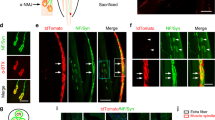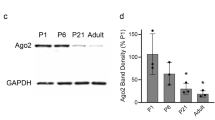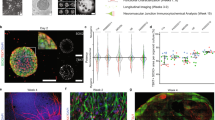Abstract
Muscle spindles are skeletal muscle sensory organs that provide axial and limb position information (proprioception) to the central nervous system. Spindles consist of encapsulated muscle fibers (intrafusal fibers) that are innervated by specialized motor and sensory axons. Although the molecular mechanisms involved in spindle ontogeny are poorly understood, the innervation of a subset of developing myotubes (type I) by peripheral sensory afferents (group Ia) is a critical event for inducing intrafusal fiber differentiation and subsequent spindle formation1,2,3. The Egr family of zinc-finger transcription factors, whose members include Egr1 (NGFI-A), Egr2 (Krox-20), Egr3 and Egr4 (NGFI-C), are thought to regulate critical genetic programs involved in cellular growth and differentiation (refs 4, 5, 6, 7, 8 and W.G.T. et al., manuscript submitted). Mice deficient in Egr3 were generated by gene targeting and had gait ataxia, increased frequency of perinatal mortality, scoliosis, resting tremors and ptosis. Although extrafusal skeletal muscle fibers appeared normal, Egr3-deficient animals lacked muscle spindles, a finding that is consistent with their profound gait ataxia. Egr3 was highly expressed in developing muscle spindles, but not in Ia afferent neurons or their terminals during developmental periods that coincided with the induction of spindle morphogenesis by sensory afferent axons. These results indicate that type I myotubes are dependent upon Egr3-mediated transcription for proper spindle development.
This is a preview of subscription content, access via your institution
Access options
Subscribe to this journal
Receive 12 print issues and online access
$209.00 per year
only $17.42 per issue
Buy this article
- Purchase on Springer Link
- Instant access to full article PDF
Prices may be subject to local taxes which are calculated during checkout






Similar content being viewed by others
References
Kucera, J., Fan, G., Jaenisch, R., Linnarsson, S. & Ernfors, P. Dependence of developing group Ia afferents on neurotrophin-3. J. Comp. Neurol. 363, 307–320 (1995).
Kucera, J. & Walro, J.M. Origin of intrafusal fibers from a subset of primary myotubes in the rat. Anat. Embryol. (Berl) 192, 149–158 (1995).
Zelená, J. The morphogenic influences of innervation on the ontogenic development of muscle spindles. J. Embryol. Exp. Morphol. 5, 283–292 (1957).
Lee, S.L. et al. Luteinizing hormone deficiency and female infertility in mice lacking the transcription factor NGFI-A (Egr-1). Science 273, 1219–1221 (1996).
Nguyen, H.Q., Hoffman-Liebermann, B. & Liebermann, D.A. The zinc finger transcription factor Egr-1 is essential for and restricts differentiation along the macrophage lineage. Cell 72, 197–209 (1993).
Sukhatme, V.P. et al. A zinc finger-encoding gene coregulated with c-fos during growth and differentiation, and after cellular depolarization. Cell 53, 37–43 (1988).
Sham, M.H. et al. The zinc finger gene Krox20 regulates HoxB2 (Hox2.8) during hindbrain segmentation. Cell 72, 183–196 (1993).
Swiatek, P.J. & Gridley, T. Perinatal lethality and defects in hindbrain development in mice homozygous for a targeted mutation of the zinc finger gene Krox20. Genes Dev. 7, 2071–2084 (1993).
Kucera, J. & Walro, J.M. Superfluousness of motor innervation for the formation of muscle spindles in neonatal rats. Anat. Embryol. (Berl) 186, 301–309 (1992).
Topilko, P. et al. Krox-20 controls myelination in the peripheral nervous system. Nature 371, 796–799 (1994).
Celio, M.R. Calbindin D-28k and parvalbumin in the rat nervous system. Neuroscience 35, 375–475 (1990).
Copray, J.C., Mantingh-Otter, I.J. & Brouwer, N. Expression of calcium-binding proteins in the neurotrophin-3-dependent subpopulation of rat embryonic dorsal root ganglion cells in culture. Brain Res. Dev. Brain Res. 81, 57–65 (1994).
Duchen, L.W. & Scaravilli, F. The structure and composition of peripheral nerves and nerve roots in the Sprawling mouse. J. Anat. 123, 763–775 (1977).
Kawamura, Y., Okazaki, H., O’Brien, P.C. & Dych, P.J. Lumbar motoneurons of man: I) number and diameter histogram of alpha and gamma axons of ventral root. J. Neuropathol. Exp. Neurol. 36, 853–860 (1977).
Yamagata, K. et al. Egr3/Pilot, a zinc finger transcription factor, is rapidly regulated by activity in brain neurons and colocalizes with Eg1/zif268. Learning and Memory 1, 140–152 (1994).
Morris, M.E., Viswanathan, N., Kuhlman, S., Davis, F.C. & Weitz, C.J. A screen for genes induced in the suprachiasmatic nucleus by light. Science 279, 1544–1547 (1998).
Ernfors, P., Lee, K.F., Kucera, J. & Jaenisch, R. Lack of neurotrophin-3 leads to deficiencies in the peripheral nervous system and loss of limb proprioceptive afferents. Cell 77, 503–512 (1994).
Klein, R. et al. Disruption of the neurotrophin-3 receptor gene trkC eliminates la muscle afferents and results in abnormal movements. Nature 368, 249–251 (1994).
Farinas, I., Jones, K.R., Backus, C., Wang, X.Y. & Reichardt, L.F. Severe sensory and sympathetic deficits in mice lacking neurotrophin-3. Nature 369, 658–661 (1994).
Tessarollo, L., Vogel, K.S., Palko, M.E., Reid, S.W. & Parada, L.F. Targeted mutation in the neurotrophin-3 gene results in loss of muscle sensory neurons. Proc. Natl Acad. Sci. USA 91, 11844–11848 (1994).
Ringstedt, T., Kucera, J., Lendahl, U., Ernfors, P. & Ibanez, C.F. Limb proprioceptive deficits without neuronal loss in transgenic mice overexpressing neurotrophin-3 in the developing nervous system. Development 124, 2603–2613 (1997).
McMahon, A.P. & Bradley, A. The Wnt-1 (int-1) proto-oncogene is required for development of a large region of the mouse brain. Cell 62, 1073–1085 (1990).
O’Donovan, K.J., Wilkens, E.P. & Baraban, J.M. Sequential expression of Egr-1 and Egr-3 in hippocampal granule cells following electroconvulsive stimulation. J. Neurochem. 70, 1241–1248 (1998).
Mithani, S., Atmadja, S., Baimbridge, K.G. & Fibiger, H.C. Neuroleptic-induced oral dyskinesias: effects of progabide and lack of correlation with regional changes in glutamic acid decarboxylase and choline acetyltransferase activities. Psychopharmacology (Berl) 93, 94–100 (1987).
Crow, M.T. & Stockdale, F.E. Myosin expression and specialization among the earliest muscle fibers of the developing avian limb. Dev. Biol. 113, 238–254 (1986).
Brooke, M.H. & Kaiser, K.K. Three “myosin adenosine triphosphatase” systems: the nature of their pH lability and sulfhydryl dependence. J. Histochem. Cytochem. 18, 670–672 (1970).
Acknowledgements
We greatly appreciate technical assistance from L. Cabalka Tourtellotte, G. Gavrilina, T. Gorodinsky, C. Bollinger and L. Roberts. We thank E. Johnson, J. Lichtman, J. Sanes and B. Snider for their comments and suggestions during the preparation of this manuscript. The antibodies to Parvalbumin (R301), slow-tonic myosin heavy chain (S46) and Egr3 were generous gifts from K. Baimbridge, F. Stockdale and J. Baraban, respectively. A. Pestronk generously provided the ATPase histochemistry protocols. This work was supported by MH1426 (W.G.T.) and CA13730 (J.M.).
Author information
Authors and Affiliations
Corresponding author
Rights and permissions
About this article
Cite this article
Tourtellotte, W., Milbrandt, J. Sensory ataxia and muscle spindle agenesis in mice lacking the transcription factor Egr3. Nat Genet 20, 87–91 (1998). https://doi.org/10.1038/1757
Received:
Accepted:
Issue Date:
DOI: https://doi.org/10.1038/1757
This article is cited by
-
Intrafusal-fiber LRP4 for muscle spindle formation and maintenance in adult and aged animals
Nature Communications (2023)
-
Transcription factor EGR2 controls homing and pathogenicity of TH17 cells in the central nervous system
Nature Immunology (2023)
-
Molecular identity of proprioceptor subtypes innervating different muscle groups in mice
Nature Communications (2022)
-
Identification of activity-induced Egr3-dependent genes reveals genes associated with DNA damage response and schizophrenia
Translational Psychiatry (2022)
-
Predictive value of single-nucleotide polymorphisms in curve progression of adolescent idiopathic scoliosis
European Spine Journal (2022)



